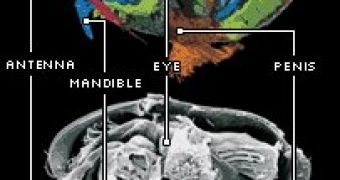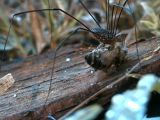Before searching for the oldest penis, we must establish when it could have appeared.
The penis exists only in those animals that have an internal fecundation, animals which lay eggs or deliver living offspring, but the sperm must fertilize the egg inside the female's body.
The lineages that evolved internal fecundation are not many. Some are aquatic: cephalopods (squids, octopuses, cuttlefish), snails (the terrestrial ones, too), crustaceans (only some of them), and sharks. Most are terrestrial, as life on the ground is devoid of water help at the moment of insemination.
On land, insects, spiders, snails, reptiles, birds (just few), and mammals have penises. Cephalopods are about 500 million years old, snails too; crustaceans are over 520 million years old. Sharks are about 450 million years old while insects 415 million years old.
The oldest known reptiles are 315 million years old (birds and mammals, being evolved from reptiles, inherited the penis from them).
Of course, these dates are just suppositions of the emergency of a copulatory organ in a group, as it may have evolved before or after its appearance.
The problem is that the penis of the vertebrates and cephalopods, being fleshy, it cannot fossilize. The shark's penis has cartilages, but these seldom fossilize.
Perhaps only the mummified penises of the pharaohs are the only fleshy ones that can come from the past.
Most mammals have a penis bone (it lacks just in humans, horses, donkeys, rhinoceros, marsupials, rabbits, cetaceans (whales and dolphins), elephants and hyenas), but it is not attached to the skeleton, and hard to find in fossils.
Fossils of cave bear penis bones have been found.
In fact, only in arthropods (like crustaceans, spiders, insects), as their penis has an exoskeleton, there are real chances of finding fossil penises.
Indeed, the oldest fossil penis is that of an ocean-dwelling ostracode crustacean, Colymbosathon ecplecticos ("amazing swimmer with a large penis"), found in 425-million-year-old rocks in the UK. The 5 mm long ancient ostracode had been buried in volcanic ash during the Silurian Period, and had been well preserved, his soft tissues included.
The 2003 discovered fossil is remarkably similar to some modern ostracodes.
A remarkable old male genitalia was found in the 400-million-year-old fossil of a harvestman or daddy longlegs, a non-web-spinning arachnid, related to mites, ticks and spiders. This 2001 find was discovered in rocks from the village of Rhynie, near Aberdeen in Scotland. Despite the great age of the fossils, they are almost identical to current harvestmen.
This is the oldest penis in a terrestrial species to be found.

 14 DAY TRIAL //
14 DAY TRIAL // 
